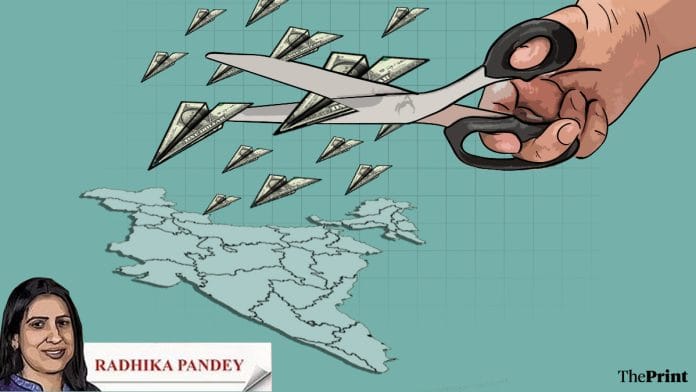Global markets are all set to witness a series of rate cuts in the near term. Last week, the European Central Bank (ECB) announced a quarter-point interest rate cut—its second reduction this year. The cut was a response to sluggish economic growth and cooling inflation.
In the US, inflation has cooled, but is still above the two percent target. Sub three percent inflation and above five percent federal funds rate sit at odds. Hence, a rate cut by the US Federal Reserve was expected. The debate was about the quantum of the rate cut. Many had anticipated a 25 basis point reduction to avoid having to reverse course in the event of premature easing of interest rates.
The US Fed’s Federal Open Market Committee (FOMC) opted to cut the benchmark rate by 50 basis points owing to a slowdown in the labour market. With a steeper rate cut, the US Fed has signalled it is not behind the curve. In the previous tightening cycle, the US Fed was criticised for being behind the curve in raising the policy rate, even though inflationary pressures were building up.
Eleven of 12 members voted for a 50 basis point rate cut, which brings the federal funds rate in the range of 4.75-5 percent from 5.25-5.5 percent. FOMC members see the benchmark interest rate falling by another 50 basis points this year, 100 basis points next year and finally by 50 basis points in 2026.
The labour market in the US has also cooled, but not at an alarming pace. Total non-farm payroll employment increased by 142,000 in August—in line with expectations, but lower than the average monthly gain over the past 12 months.
The unemployment rate edged lower to 4.2 percent in August from 4.3 percent in July, alongside a positive growth in real average earnings. US consumer spending remained strong, increasing by 0.1 percent month-on-month, despite a slowdown in the labour market. Real Gross Domestic Product posted a decent growth of three percent in the April-June quarter, up from 1.4 percent in the January-March quarter.

Also Read: Bad economics of freebies is triggering financial crises for some states. Fiscal discipline is key
What led to elevated interest rates?
In the aftermath of the Covid pandemic, the US Fed had raised interest rates to combat the surge in inflation. Supply side bottlenecks and a resurgence in consumer demand owing to the fiscal stimulus led to rise in inflation.
By the middle of 2022, inflation in the US had risen to almost nine percent. Between March 2022 and July 2023, the US Federal Reserve raised interest rate 11 times, pushing the federal funds rate to above five percent from near zero. The sharp rise in the interest rates pushed the value of the dollar compared to other currencies.
Impact on India
With policy rate cuts by the Fed, the difference between the interest rates in India and US could widen, making India more attractive for the currency carry trade. The lower the rate in the US, the higher the arbitrage opportunity, till the time when the rate-cut cycle begins in India.
Both the NSE (National Stock Exchange) Nifty and BSE (Bombay Stock Exchange) Sensex have been scaling new peaks on expectations of rate cut. As the cuts have been factored in, Indian markets could see a correction, post the announcement of the rate cut.
Foreign Portfolio Investors have made a comeback in the Indian market. Their overall net buying of debt and equity till the middle of September has been more than the whole of the previous month.
Bond yields have also rallied in response to the expectations of a rate cut. The benchmark 10 year government bond dropped to below seven percent on expectations of rate cut.
Typically, the inflow of foreign capital could lead to strengthening of the Rupee. But the sustained response would depend on Reserve Bank of India’s monetary and exchange rate policy. If the RBI intervenes in the foreign exchange market to stem the appreciation of the Rupee, the expected impact on the exchange rate may not play out.
Intervention in the exchange rate market to prevent a steep appreciation may lead to liquidity injection, contributing to domestic inflation. RBI has been actively intervening in the exchange market. While the Dollar index has exhibited considerable volatility since 2022, the Rupee-Dollar rate has been relatively stable.

A US rate cut could lower global borrowing costs, making it cheaper for companies to raise funds internationally.
US & India monetary policy
The impact of the rate cut in the US will also depend on the interest rate decisions by the RBI. While arguably, the decision on the policy rate is based on domestic inflation and growth considerations, interestingly, the trajectory of the Indian policy rate is seen to be similar to that of the US federal funds rate.
The RBI commenced its rate hike in May 2022 through an unscheduled policy meeting. Interestingly, the unscheduled meeting was called on the day the US FOMC was set to announce a rate hike.
The RBI raised the policy rate by 40 basis points and the US Fed announced a 50 basis point hike on 4 May, 2022. Subsequently, both the US Fed and RBI raised rates. Had the RBI not adjusted its policy rate, the Rupee could have faced significant depreciation pressure.
The RBI paused its rate hike cycle in February 2023, while the US Fed followed a tight monetary policy till July 2023.

While the interest rate cut by the US Fed may not result in a cut by the RBI in its October meeting, it will likely nudge the Monetary Policy Committee to consider changing the stance of the monetary policy to neutral.
Radhika Pandey is associate professor and Madhur Mehta is a research fellow at the National Institute of Public Finance and Policy (NIPFP).
Views are personal.
Also Read: India saw slower growth in Q1, but consumption, non-govt investment, manufacturing were reassuring






